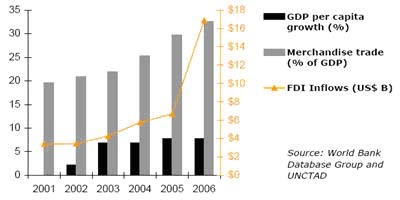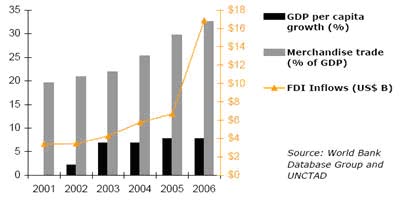The BRIC Emerging Economies
While economists consider the G8 countries (Canada, France, Germany, Italy, Japan, Russia, the United Kingdom, and the US, plus the European Union) to be the most prominent economies, they also recognize certain emerging economies, collectively called the BRIC, as major upcoming market players.
The BRIC economies include the rapidly growing and emerging markets of Brazil, Russia, India and China. The BRIC have accomplished phenomenal growth since embracing the path of global capitalism and are now predicted to be on the forefront of the world’s list of leading economies. China is already the world’s second largest economy on the basis of purchasing power parity (PPP).
While the average wealth levels of individuals in developed economies will continue to surpass that of the BRIC economies in per person wealth, there will be an incremental increase in the already growing middle class population of the BRIC economies. Assuming that the governments of these nations continue to implement growth supportive policies, India and China will be seen to take the roles of dominant suppliers of manufactured goods and services, while Brazil and Russia may become dominant suppliers of raw materials.


This BRIC webpage has been designed to assist readers in having a better understanding of the BRIC emerging markets. This webpage includes the following information:
BRIC Reports
Below are several key reports on the BRIC and other emerging economies. Other reports will be added as they become available, so check back frequently.
Dreaming with BRICs: The Path to 2050 - Global Economics Paper No. 99
The Goldman Sachs Global Economics Department
This 2003 assessment of the BRIC economies asserted that the rapidly growing economies of Brazil, Russia, India, and China could be included in the list of the major players of the world economy by 2050 provided that their 2003 economic trends continued. This would imply that the combined BRIC economies could account for over half the size of the G6 by 2025 and could be larger than those of the G6 in US dollars terms by 2050.
Website: http://www2.goldmansachs.com/ideas/brics/book/99-dreaming.pdf
BRICs and Beyond
The Goldman Sachs Global Economics Department
Since Goldman Sachs coined the term "BRIC" in the 2001 publishing of their Global Economics Paper, "Building Better Global Economic BRICs", the BRIC countries have achieved a stupendous growth in their value. Published in 2007, this book, BRICs and Beyond, compiles the follow-up reports and more recent research on the BRICs and the changing nature of the global economy.
Website: http://www2.goldmansachs.com/ideas/brics/BRICs-and-Beyond.html
Entrepreneurship in Emerging Economies: The Creation and Development of New Firms in Latin America and East Asia
Inter-American Development Bank; Hugo Kantis, National University of General Sarmiento: Institute of Industry; Masahiko Ishida and Masahiko Komori, Development Bank of Japan, Japan Economic Research Institute
Entrepreneurship is receiving greater attention from policymakers and experts in developed and developing countries. New dynamic enterprises contribute to economic development in several ways: as an important channel to convert innovative ideas into economic opportunities, as the basis for competitiveness through the revitalization of social and productive networks, as a source of new employment, and as a way to increase productivity.
Website: http://www.iadb.org/sds/doc/IDBEnglishBookfinal.pdf
Unleashing Entrepreneurship: Making Business Work for the Poor
Commission on the Private Sector and Development
United Nations Development Programme
In this report to United Nations Secretary-General Kofi Annan, the Commission on Private Sector and Development focuses on how business can create domestic employment and wealth, free local entrepreneurial energies, and help achieve the Millennium Development Goals.
Website:http://www.undp.org/cpsd/report/index.html
BRIC Related Websites
There are a growing number of online resources to help entrepreneurs establish business enterprises in emerging markets. Below is a list of websites which provide information on emerging markets.
FDI.net
FDI.net is a web site which promotes foreign direct investment in emerging markets. It offers free country analyses and information related to foreign direct investment in 175 countries. The site combines business and public resources with World Bank Group analyses to provide users with a full-spectrum of information needed to make a decision about investing in a foreign country
Website: http://www.fdi.net/
Endeavor.org
Endeavor is a non-profit group based in New York that targets emerging market countries that are transitioning from international aid to international investment. It supports entrepreneurship in emerging markets to help create jobs, generate wealth, inspire individuals to take on entrepreneurship, and contribute to the economic and social development of emerging-market countries. /p>
Website: http://www.endeavor.org/
doingbusiness.org
This website provides objective measures of business regulations and their enforcement across 178 economies and selected cities at the subnational and regional levels. It allows users to evaluate regulations that directly impact economic growth, download business laws and regulations, make cross-country comparisons, and identify good practice reforms.
Website: http://www.doingbusiness.org/
Worldinformation.com
This website provides country related information on key business sectors in the world’s major markets, including finance, international investment, property, and energy. It also provides detailed information on a wide variety of topics for every country in the world.
Website: http://worldinformation.com/
Expertsonline.tv
Expertsonline.tv is an online Business TV Channel for people starting or growing a business. The purpose of Expertsonline.tv is to help entrepreneurs learn from experts, network with each other, and develop a business and entrepreneur Community.
Website: http://www.expertsonline.tv/members/index2.php
BRIC Country Overviews
| Brazil | Russia |
|---|---|---|
Statistics |
|
|
GDP 2007 | $1.314 trillion | $1.286 trillion |
GDP Growth 2007 | 5.40% | 8.10% |
GDP by sector | Agriculture: 5.5% Industry: 28.7% Services: 65.8% | Agriculture: 4.7% Industry: 39.1% Services:56.2% |
Inflation | 3.60% | 11.90% |
Population | 191,908,598 | 140,702,094 |
Labor force | 99.47 million | 74.1 million |
Labor force by occupation | Agriculture: 20% Industry: 14% | Agriculture: 10.8% Industry: 28.8% |
Unemployment | 9.30% | 6.20% |
Trade |
|
|
Exports | $160.6 billion | $365 billion |
Export goods | transport equipment, iron ore, soybeans, footwear, coffee, autos | petroleum and petroleum products, natural gas, wood and wood products, metals, chemicals, and a wide variety of civilian and military manufactures |
Main export partners | US 14.2%, China 9.2%, Argentina 8.3%, Germany 4.4%, Netherlands 4.3% | Germany 9.5%, Netherlands 7.5%, Turkey 6%, Italy 5.6%, Ukraine 5%, China 5%, US 4.8%, Belarus 4.6%, Switzerland 4% |
Imports | $120.6 billion | 260.4 billion |
Import goods | machinery, electrical and transport equipment, chemical products, oil, automotive parts, electronics | machinery and equipment, consumer goods, medicines, meat, sugar, semi-finished metal products |
Main import partners | US 20%, China 8.9%, Argentina 8.1%, Germany 7.6% | Germany 16.3%, China 12.4%, Italy 5.5%, Ukraine 5.1%, Japan 4.9%, Belarus 4% (2006) |
| India | China |
|---|---|---|
Statistics |
|
|
GDP 2007 | $1.099 trillion | $3.251 trillion |
GDP Growth 2007 | 9.20%(2007) | 11.40% |
GDP by sector | Agriculture: 17.6% Industry: 29.4% Services: 52.9% | Agriculture: 11.3% Industry: 48.6% Services: 40.1% |
Inflation | 6.40% | 4.80% |
Population | 1,147,995,898 | 1,330,044,605 |
Labor force | 516.4 million | 803.3 million |
Labor force by occupation | Agriculture: 60% Industry: 12% | Agriculture: 43% Industry: 25% |
Unemployment | 7.20% | 4% |
Trade |
|
|
Exports | $150.8 billion | $1.217 trillion |
Export goods | petroleum products, textile goods, gems and jewelry, engineering goods, chemicals, leather manufactures | machinery, electrical products, data processing equipment, apparel, textile, steel, mobile phones |
Main export partners | US 15.1%, UAE 8.8%, China 8.4%, UK 4.3% | US 19.4%, Hong Kong 15.2%, Japan 8.4%, South Korea 4.6%, Germany 4.1% (2006) |
Imports | $230.2 billion | $901.3 billion |
Import goods | crude oil, machinery, gems, fertilizer, chemicals | machinery and equipment, oil and mineral fuels, plastics, LED screens, data processing equipment, optical and medical equipment, organic chemicals, steel, copper |
Main import partners | China 10.5%, US 7.8%, Germany 4.5%, Singapore 4.5% | Japan 13.9%, South Korea 11%, Taiwan 10.6%, US 7.5%, Germany 4.7% |




